

Heat Pipe Technology, Inc. - Advanced Energy Recovery and Dehumidification. Using Heat to Cool Buildings. It could soon be more practical to cool buildings using solar water heaters and waste heat from generators.

That’s because of new porous materials developed by researchers from the Pacific Northwest National Laboratory. These materials can improve a process called adsorption chilling, which can be used for refrigeration and air conditioning. Adsorption chillers are too big and expensive for many applications, such as use in homes. Peter McGrail, who heads the research effort, predicts that the materials could allow adsorption chillers to be 75 percent smaller and half as expensive. Einstein refrigerator. Einstein's and Szilárd's patent application.
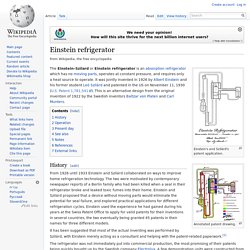
Annotated patent drawing. History[edit] ClimateWell. ISAAC Solar Ice Maker. AbsorptionPowerCycle.PDF (application/pdf Object) Daikin Industries, Ltd. Sopogy. Sopogy a solar thermal technology supplier was founded in 2002 at the Honolulu, Hawaii based clean technology incubator known as Energy Laboratories.
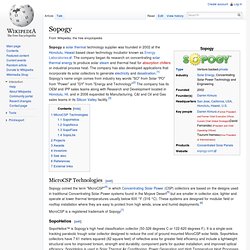
The company began its research on concentrating solar thermal energy to produce solar steam and thermal heat for absorption chillers or industrial process heat. The company has also developed applications that incorporate its solar collectors to generate electricity and desalination.[1] Sopogy's name origin comes from industry key words "SO" from Solar "PO" from "Power" and "GY" from "Energy and Technology"[2] The company has its OEM and IPP sales teams along with Research and Development located in Honolulu, HI, and in 2006 expanded its Manufacturing, C&I and Oil and Gas sales teams in its Silicon Valley facility.[3] MicroCSP Technologies[edit]
Solar air conditioning. Solar air conditioning refers to any air conditioning (cooling) system that uses solar power.
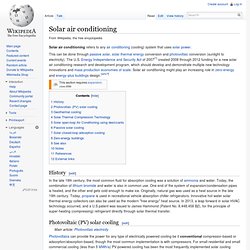
This can be done through passive solar, solar thermal energy conversion and photovoltaic conversion (sunlight to electricity). Absorption heat pump. Absorption heat pump is essentially an air-source heat pump driven not by electricity, but by a heat source such as solar-heated water, or geothermal-heated water.
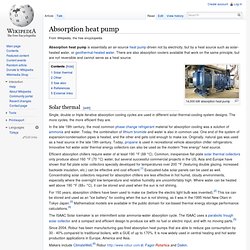
There are also absorption coolers available that work on the same principle, but are not reversible and cannot serve as a heat source. 14,000 kW absorption heat pump Solar thermal[edit] Single, double or triple iterative absorption cooling cycles are used in different solar-thermal-cooling system designs. Absorption refrigerator. An absorption refrigerator is a refrigerator that uses a heat source (e.g., solar, kerosene-fueled flame, waste heat from factories or district heating systems) to provide the energy needed to drive the cooling system.

In the early years of the twentieth century, the vapor absorption cycle using water-ammonia systems was popular and widely used, but after the development of the vapor compression cycle it lost much of its importance because of its low coefficient of performance (about one fifth of that of the vapor compression cycle).
Nowadays, the vapor absorption cycle is used only where waste heat is available or where heat is derived from solar collectors. Absorption refrigerators are a popular alternative to regular compressor refrigerators where electricity is unreliable, costly, or unavailable, where noise from the compressor is problematic, or where surplus heat is available (e.g., from turbine exhausts or industrial processes, or from solar plants). Absorption Principles[edit] Ammonia / Water Absorption Refrigeration. Water and ammonia combine easily.
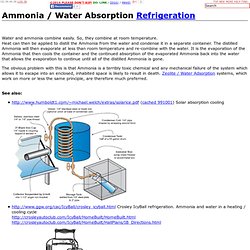
So, they combine at room temperature. Heat can then be applied to distill the Ammonia from the water and condense it in a separate container. The distilled Ammonia will then evaporate at less than room temperature and re-combine with the water. It is the evaporation of the Ammonia that then cools the container and the continued absorption of the evaporated Ammonia back into the water that allows the evaporation to continue until all of the distilled Ammonia is gone.
Prone to wander...: Of Ammonia Absorption Refrigeration & the Like... It's interesting that I have not written anything here yet this year, not even a Happy New Year.
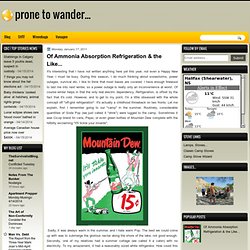
I must be busy. During this season, I do much thinking about snowstorms, power outages, survival etc. I like to think that most bases are covered. I have enough firewood to last me into next winter, so a power outage is really only an inconvenience at worst. Of course winter helps in that the only real electric dependency, Refrigeration, is offset by the fact that it's cold. Sadly, it was always warm in the summer, and I hate warm Pop. The only thing missing from the whole equation was the concept of "portability".
Electrolux. This article presents a brief explanation of how an absorption-cycle refrigerator functions.

An example of this refrigerator is the Electrolux, a kitchen refrigerator which was manufactured by Servel, Inc. of Evansville, Indiana. This refrigerator had no compressor or valves, just a small flame or electric heater, and worked continuously without noise or vibration. In spite of their advantages, absorption refrigerators are not much used at present. First, we should review the operation of the compression-cycle refrigerator, which is by far the most common type. The refrigerant is compressed, and then gives up heat to the environment, condensing to a liquid. Google Image Result for. Crosley IcyBall. Crosley bought the rights to the Icyball refrigeration idea, and brought it to market.
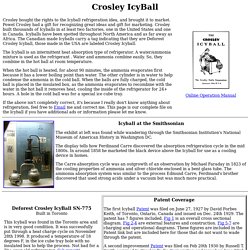
Powel Crosley had a gift for recognizing great ideas and gift for marketing. Crosley built thousands of Icyballs in at least two factories, one in the United States and one in Canada. Icyballs have been spotted throughout North America and as far away as Africa. Home Built IcyBall. Building Your Own Larry Hall Icyball. Solarice.pdf (application/pdf Object) Finalfridgereport1.pdf (application/pdf Object) Michigan State University 2009 « The Appropriate Technology Collaborative. Michigan State University World Challenge Design Team 2009 Our Michigan State University student design team recently (2009) returned from Guatemala where they demonstrated the ATC/MSU design of a solar vaccine refrigerator. (The MSU students deserve all the credit here) This remarkable invention works. Period. Put it in the sun and it will keep vaccines very cold.
Background: Over half of all vaccines spoil due to temperature before they reach the people who so desperately need them in rural Africa and parts of Asia. From the MSU Student Presentation: Many of the vaccines used to control diseases require cold temperatures for preservation.